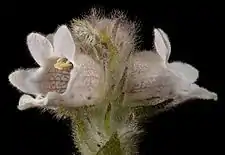Hemiphora
Hemiphora is a genus of five species of flowering plants in the mint family, Lamiaceae and is endemic to Western Australia. Plants in this genus are woolly shrubs with warty, hairy leaves and with five petals joined to form a tube-shaped flower with four stamens. These species are similar to those in the genus Chloanthes in that the base of the leaves extends down the stem. They differ from Chloanthes, in that the leaves only extend a short distance down the stem.
| Hemiphora | |
|---|---|
 | |
| Flower of Hemiphora bartlingii | |
| Scientific classification | |
| Kingdom: | Plantae |
| Clade: | Tracheophytes |
| Clade: | Angiosperms |
| Clade: | Eudicots |
| Clade: | Asterids |
| Order: | Lamiales |
| Family: | Lamiaceae |
| Subfamily: | Prostantheroideae |
| Genus: | Hemiphora (F.Muell.) F.Muell.[1] |
| Species | |
|
See text | |
Description
Plants in the genus Hemiphora are evergreen shrubs which have their stems, leaves and parts of their flowers densely covered with woolly hairs. The leaves are simple and are arranged in opposite pairs or in whorls of three, covered with woolly hairs and small blisters. The leaves appear narrow because their edges are turned under, so that the lower surface of the leaf is not visible. The flowers are arranged singly in leaf axils and are surrounded by leaf-like bracts and two bracteoles. Flowers have five sepals which are joined at their base to form a very short tube with five lobes. The five petals are joined to form a curved tube with five lobes, the lower lobe roughly triangular in shape, the two side lobes and the upper two all similar in size and shape. There are four stamens sometimes with the lower pair shorter than the upper ones or sterile.[2][3][4]
Taxonomy and naming
In 1876, Ferdinand von Mueller described Chloanthes elderi and placed it in the section Chloanthes sect. Hemiphora.[5] In 1882, Mueller raised Hemiphora to genus so that Hemiphora elderi became the type species of the new genus.[1][6] In 2011, Barry Conn, Murray Henwood and Nicola Streiber transferred four species, previously in the genus Pityrodia into Hemiphora.[2]
Distribution
All species of Hemiphora are endemic to Western Australia.[3]
The species are:
- Hemiphora bartlingii (Lehm.) B.J.Conn & Henwood
- Hemiphora elderi (F.Muell.) F.Muell
- Hemiphora exserta (Benth.) B.J.Conn & Henwood
- Hemiphora lanata (Munir) B.J.Conn & Henwood
- Hemiphora uncinata (Turcz.) B.J.Conn & Henwood
References
- "Hemiphora". APNI. Retrieved 30 November 2016.
- Conn, Barry J.; Henwood, Murray J.; Streiber, Nicola (2011). "Synopsis of the tribe Chloantheae and new nomenclatural combinations in Pityrodia s.lat. (Lamiaceae)". Australian Systematic Botany. 24 (1): 1–9. doi:10.1071/SB10039.
- "Hemiphora". FloraBase. Retrieved 30 November 2016.
- Corrick, Margaret G.; Fuhrer, Bruce A (2009). Wildflowers of southern Western Australia (3rd ed.). Kenthurst, N.S.W.: Rosenberg Publishing. p. 45. ISBN 9781877058844.
- von Mueller, Ferdinand (1876). "Chloanthes". Fragmenta phytographiae Australiae. 10: 13. Retrieved 30 November 2016.
- von Mueller, Ferdinand (1882). Systematic Census of Australian Plants. Melbourne. p. 103. Retrieved 30 November 2016.
{{cite book}}: CS1 maint: location missing publisher (link)
External links
- Hemiphora occurrence data from Australasian Virtual Herbarium
 Media related to Hemiphora at Wikimedia Commons
Media related to Hemiphora at Wikimedia Commons Data related to Hemiphora at Wikispecies
Data related to Hemiphora at Wikispecies